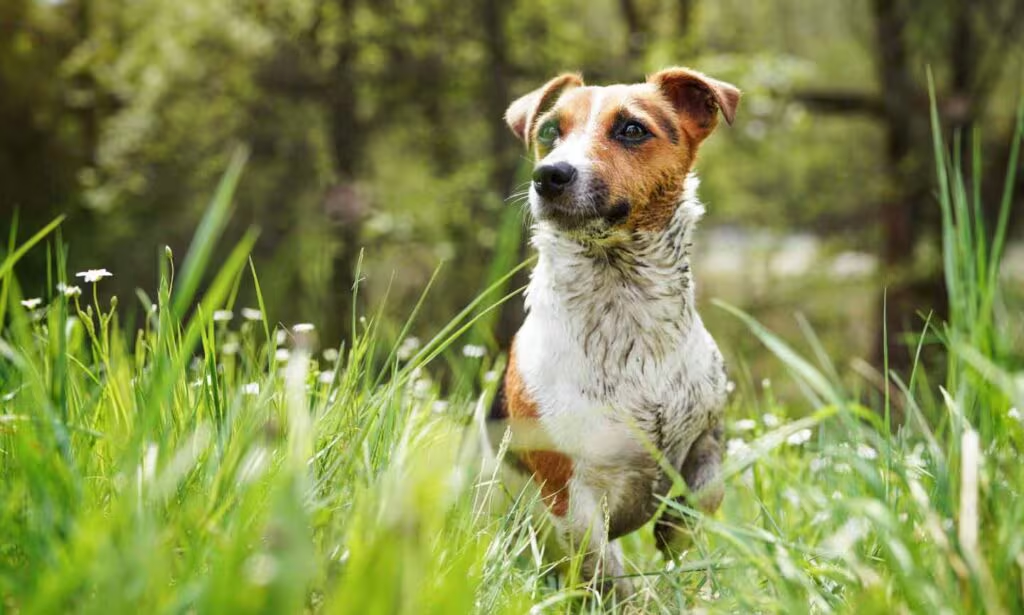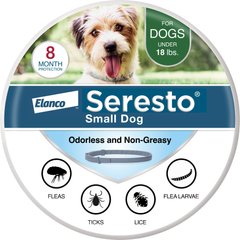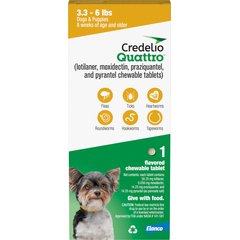Ticks on Dogs: Everything You Need To Know

Photo by iStock.com/Lubo Ivanko
You’re running your hands through your dog’s fur and… wait, what’s that bump? You carefully part their fur. It’s brown (or maybe gray) and stuck in your dog’s skin—it’s a tick!
Ticks on dogs are more than just gross. They can also carry dangerous diseases like Lyme disease.
Regular tick checks, prompt removal of ticks, and using tick preventives are key to keeping your dog comfortable and healthy.
Key Takeaways
- Ticks can carry serious diseases like Lyme disease and Rocky Mountain spotted fever.
- Check your dog regularly for ticks—especially after time outdoors.
- Prompt removal of ticks and year-round tick preventives are essential for keeping your dog healthy.
What Are Ticks?
Ticks are parasites, meaning that to survive, they must live on a host for at least part of their life cycle. When they are on that host, they have the potential to do harm—in the case of ticks, that harm comes from transmitting dangerous and sometimes life-threatening diseases like Lyme disease and Rocky Mountain Spotted Fever. (More on those later.)
While ticks look a little bit like insects, they are actually arachnids, making them more closely related to spiders and mites.
What Do Ticks on Dogs Look Like?

iStock.com/antpkr
All of the most common types of ticks that pet parents find on their dogs are categorized as hard ticks because when they are adults, most of the top of their body (behind their mouth parts) is covered by a hard shield.
Tick color, size, and markings vary based on factors like type, sex, and life stage. In general, ticks can be brown, black, gray, or sometimes have a reddish tint. They’re pretty tiny—about 3–5 mm long—and some grow in size when engorged with blood.
Most of the time, if you find a tick on your dog, it will be an eight-legged adult. Let’s take a look at the tick life cycle.
- Egg: Adult female ticks can lay thousands of eggs in the environment. These eggs are extremely tiny, usually red or brown in color, and may appear translucent.
- Larvae: Tick larvae are tiny and have six legs. They usually feed on small mammals like mice and are not often found on dogs.
- Nymph: After the larvae feed on their host’s blood, they will molt into nymphs. Nymphs have eight legs and look like smaller versions of adult ticks. Depending on the species of tick, the nymphs may feed on small mammals or “graduate” to larger species like dogs.
- Adult: Before they have eaten, adult ticks are usually flat and mostly brown. When they are fully engorged with blood, they can be grayer in color and plump like a small grape. After feeding, ticks will mate and drop off their hosts. Females will then lay their eggs, which completes their life cycle.
Types of Dog Ticks
Many different kinds of ticks can be found on dogs. In North America, four types are most common. We’re breaking down what each one looks like and what health threats they may carry.
1. American Dog Tick (Dermacentor variabilis and Dermacentor similis)
The American dog tick is most prevalent in the eastern U.S., the Midwest, California, and the Pacific Northwest. Adult American dog ticks are brown with numerous small white spots or streaks on their backs. They can be active all year round, but especially in the spring, and are often found in grassy fields or along the edges of trails.
American dog ticks can spread Rocky Mountain spotted fever and tularemia, both of which can be deadly. American dog ticks are also the tick most associated with tick paralysis.
2. Lone Star Tick (Amblyomma americanum)
Adult Lone Star ticks are a brown or tan color. Females have a single white spot on their backs while males have several white spots. Lone Star ticks are most commonly found in the eastern, midwestern, and southeastern parts of the U.S., often along woody areas lining waterways. They tend to be most active in the late spring and early summer and can transmit many diseases, including ehrlichiosis, rickettsiosis, and tularemia.
3. Deer (Blacklegged) Tick (Ixodes pacificus and Ixodes scapularis)
Both the nymph and the adult forms of deer ticks (also called blacklegged ticks) will feed on larger animals, including deer, dogs, and people. Adults are brown or reddish-brown, with a darker shield toward the front of their bodies. Deer ticks are smaller than other common types of ticks. Adults are about the size of a sesame seed and nymphs are closer to poppy seeds in size.
Deer ticks tend to be found in wooded areas, particularly near trails, and can be active in the spring, summer, and fall. They are most common in the midwestern and eastern parts of the U.S. (Ixodes scapularis) and the California, Oregon, and Washington coasts (Ixodes pacificus). Deer ticks can transmit Lyme disease, as well as babesiosis and possibly other tick-borne diseases.
4. Brown Dog Tick (Rhipicephalus sanguineus)
Brown dog ticks are sometimes called kennel ticks because they can complete their entire life cycle indoors. While they don’t survive cold temperatures well, if they establish themselves inside a home or kennel, they can live anywhere in the U.S. Brown dog ticks are a red-brown color and like to hide in cracks and under rugs and cushions. When they attach to dogs, they’re often found between the toes or around the ears.
Brown dog ticks transmit many diseases including anaplasmosis, babesiosis, ehrlichiosis, hepatozoonosis, and Rocky Mountain spotted fever.
Many other types of ticks can also be found in the U.S. New species, such as the Asian longhorned tick, are being discovered, and established ones are expanding their ranges, possibly as a result of climate change.
Tick-Borne Diseases in Dogs
Ticks can transmit a long list of diseases and conditions that can affect dogs. The most commonly diagnosed are:
- Local reactions: Tick bites can cause local irritation and infections that usually resolve on their own or with basic first aid once the tick is removed.
- Anemia: When many ticks attach to and feed from a dog, they can remove so much blood that the dog becomes anemic. Dogs with severe anemia may require blood transfusions.
- Tick paralysis: Toxins present in a tick’s saliva can lead to weakness, unsteadiness, change in voice, paralysis, and even death in dogs who are bitten. Treatment involves removing the ticks and supportive care.
- Ehrlichiosis: There are many different types of ehrlichiosis in dogs, but most cause symptoms like fever, lethargy, swollen lymph nodes, and bleeding and bruising. Treatment can include antibiotics to kill the Ehrlichia bacteria, blood transfusions, and supportive care.
- Rocky Mountain Spotted Fever: Infections with Rickettsia rickettsii bacteria are responsible for Rocky Mountain spotted fever. Symptoms in dogs include fever, swollen lymph nodes, abnormal bleeding and bruising, coughing, vomiting, diarrhea, swollen face or legs, and pain. Treatment includes antibiotics to kill the Rickettsia bacteria and symptomatic and supportive care.
- Lyme disease: Caused by infection with Borrelia burgdorferi bacteria, dogs with Lyme disease usually develop symptoms like fever, swollen lymph nodes, and painful joints. Kidney disease is also possible. Treatment with antibiotics can help but doesn’t always eliminate the infection.
- Babesiosis: The parasites responsible for canine babesiosis (Babesia spp.) infect a dog’s red blood cells leading to fever, anemia, weakness, dark urine, pale gums, and swollen lymph nodes. Treatment involves medications to kill the parasites and symptomatic and supportive care (blood transfusions, for example).
- Tularemia (rabbit fever): Francisella tularensis bacteria can cause tularemia in dogs. Symptoms may include fever, stiffness, abscesses, and swollen lymph nodes. In dogs, most cases are mild. Appropriate antibiotics can help clear the infection.
- Anaplasmosis: The bacteria Anaplasma phagocytophilum and A. platys can both cause anaplasmosis in dogs, leading to symptoms like fever, poor appetite, joint pain, and abnormal bruising or bleeding. Treatment with appropriate antibiotics is usually successful.
- Hepatozoonosis: Dogs get hepatozoonosis by eating ticks infected with Hepatozoon parasites, often when they are self-grooming. Symptoms can include fever, pain, weight loss, weakness, discharge from the eyes and nose, swollen lymph nodes, and diarrhea. Long-term treatment with drugs to kill the parasites can help manage the disease but it often relapses.
This is not a complete list of all the diseases that ticks can carry, and new diseases are being discovered all the time. So, yeah, you’re going to want to ward off these pests—and remove them as soon as possible if you do find one on your pet.
How Dogs Get Ticks
Any dog who isn’t on an effective form of tick prevention can get ticks. Most types of ticks hang out on the edges of bushes or tall grasses. When a dog brushes by they climb aboard and then attach. This tick behavior is called “questing”—but thankfully, ticks can’t jump!
Ticks can also enter your home or yard by hitching a ride on people or other animals. If they haven’t already attached to this first potential host, they can fall off and wait for your dog to come near enough that they can climb on.
How To Find Ticks on Dogs
Always check your dogs for ticks after they have been in a place where ticks could be found. For disease transmission to occur, a tick must be attached for at least a few hours (sometimes even longer), so finding ticks quickly will help keep your dog healthy.
Slowly run your hands through your dog’s coat, looking and feeling for ticks that have attached or are crawling through your dog’s fur or on their skin. Make sure to check for ticks over your dog’s entire body, including:
- Inside and behind the ears
- Between the toes
- Under the collar or harness
- Around the eyes
- Under the tail
- In the armpits and groin
How To Remove Ticks From Dogs
If you find a tick on your dog, remove it as quickly as possible by following this step-by-step guide.
- Avoid directly handling the tick if you can. In rare cases, it’s possible to contract a tick-borne disease through breaks in your skin. Wear latex or nitrile gloves or, at the very least, protect your fingers with a paper towel. Wash your hands when you are done removing ticks.
- Fill a small disposable container with isopropyl (rubbing) alcohol. Placing any ticks that you remove in the alcohol will kill them and preserve them if you want to show them to your veterinarian for identification.
- You can remove any unattached ticks on your dog by gently pinching them between your fingers. Again, use gloves or another barrier to avoid touching the tick. Many tick-borne diseases can affect humans as well as dogs.
- If you find an attached tick, use tweezers to grasp the attached tick as close to your pet’s skin as possible so you get its mouthparts, too. Slowly pull the tick straight out of the skin. Do not twist or yank. Specially designed tick removal tools can also be helpful. Try not to squeeze the tick’s body as this may increase the chances of disease transmission.
- Do NOT try to remove a tick by soaking it in kerosene or similar liquids, burning it off with a match, or smothering it in petroleum jelly. These methods don’t work and can even increase the risk of disease transmission (and injury!) to your dog.
- If the tick’s mouthparts break off and are embedded in your dog’s skin, consult your veterinarian.
Read our step-by-step guide to removing a tick from a dog.
Talk to your veterinarian if the area around the tick bite is red, swollen, or has drainage that hasn’t gone away in a few days. Monitor your dog for signs of a tick-borne illness like lethargy, loss of appetite, swollen lymph nodes, pain, and lameness.
How To Prevent Ticks on Dogs
The best way to prevent problems associated with ticks is to stop them from biting and attaching in the first place. Many safe and effective tick preventives for dogs are now available, including:
- Flea and Tick Collars: Worn around your dog’s neck, these collars release active ingredients over time to repel or kill fleas and tick. Opt for a vet-recommended collar, like Seresto, which is an odorless, non-greasy collar that provides eight months of protection against fleas and ticks. Available without a prescription, it’s formulated for dogs and puppies at least 7 weeks old.
Recommended Product
- Oral Medications: Available in chew or tablet form, these medications are usually given once a month to protect against fleas and ticks. Some, like Credelio Quattro, protect against internal parasites as well.
Recommended Product
- Topical Treatments: Applied directly to your dog’s skin, usually monthly, topical treatments, like K9 Advantix II, typically protect against both fleas and ticks.
Recommended Product
Recommended Products
Not every type of tick preventive is appropriate for every dog. Read and follow the product’s label closely. Your veterinarian can help you pick the best form of tick control based on your dog’s lifestyle and individual needs.
Ticks can mean danger for your pet. However, keeping your dog on an effective form of tick prevention year-round and checking for “hitchhikers” after your pet goes outside can keep them protected against ticks and tick-borne diseases.
Looking for more pest prevention tips? Check out our complete flea and tick guide for your dog and your home.
Ticks on Dogs FAQs
What should I do if my dog has ticks?
If your dog has ticks, you should remove them as quickly as possible. Using a glove, tissue, or other barrier, pull unattached ticks off your dog and place them in isopropyl (rubbing) alcohol.
If the ticks are attached, use tweezers or a tick removal tool to grasp the tick as close to your pet’s skin as possible, ensuring you also remove its mouthparts. Then, slowly pull the tick straight out of the skin and place in rubbing alcohol.
Should I worry if I found a tick on my dog?
Ticks can spread disease, which could be cause for concern. Remove the tick and then watch for signs of disease, such as fever, fatigue, loss of appetite, and swollen joints. If you notice any of these signs, which may take up to a few weeks to show up, contact your veterinarian.
How long will a tick stay on a dog?
A tick can stay on a dog for several days, usually three to six days, feeding until it’s full. If not removed, some may hang on longer.








